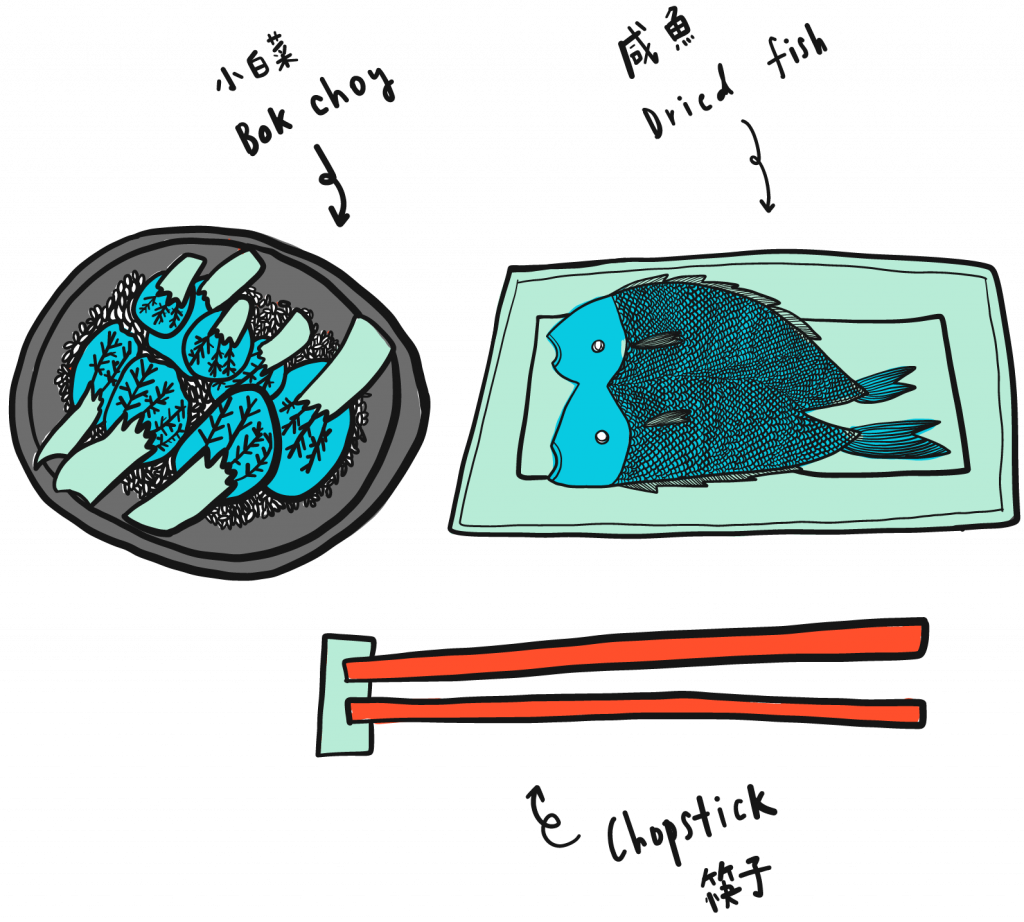As you’re tiptoeing over the shallow creeks alongside the fishmongers on the blocks of Pender and Gore, Georgia and Gore, Main and Keefer, or Main and Pender (the streets that make up Vancouver’s Chinatown proper) wondering what’s in the air you breathe and trying to avoid the murky water on the streets, you will be greeted by the inescapable, familiar, fishy, sometimes rancid, scents unique to Chinatown. No matter which street you’re on, the smells of the area can either make you appreciate the place or immediately turn away.
One of the things that contributes to the mix of what most people would find to be a difficult scent is the strong smell of mysterious- looking dried goods – more specifically, the sundried and salt-preserved seafood and vegetables that are staple ingredients commonly used in Chinese cooking. Despite their strange appearance, the ingredients in these stores are commonly used in dim sum, soups, meatloaves, vermicelli, sauces, and everything else. They’re the sugar and spice to all things that complement rice at the family table and Chinese restaurants!
Chinatown Dried Goods Museum
Dried goods stores are like museums that let people experience the smells, tastes, textures and colours that have traversed through thousands of years in a tangible and tactile way. Most products being away from immediate danger of spoiling makes it possible for visitors to access and enjoy the iconic ingredients from overseas. These are food assets that communities have formed around based on a daily need of meal sharing. The quality of the dried products being keepable helps increase the viability of the businesses. Sales and pricing decisions that help dried goods businesses survive among competitors have been influenced by information from customers via word-of-mouth. As most dried goods stores sell the same products, the mission of most shoppers would be to go from store to store in Chinatown to examine the quality of products such as mung beans, salted fish, lotus seeds, and scallions. Only after several blocks of walking and thoughtful product comparisons between price and quality will a transaction actually happen.
The way grandmas and grandpas shopping in Chinatown cherry pick through boxes of dried goods are a very lively demonstration of Chinese culture. Consider older generations of Chinese immigrants as the connoisseurs who instill in younger generations the culinary wisdom that has been passed on from pre-dated China. It’s the conversations about things like which floral pattern on Shitake mushrooms makes it good versus bad that share a kind of knowledge that’s not accessible elsewhere. These dried goods are like souvenirs from China that give insight about the cultural roots through what ingredients go into Chinese food, why these stores in Chinatown are needed by Chinese communities, and how these local businesses have created a sense of belonging for the Chinese. Dried goods can be traced back to antiquity, providing culinary and survival insight through old proven methods of food preservation discovered and used by ancestors of the past and global trade today. Through this understanding the impact of our cultural roots in a society. Preservation allows a community to participate, explore, and enjoy Chinese culture through taste, texture, and other sensorial experiences that are passed on from generation to generation: from fishermen to kings to us 2016 people, enriching and giving context to the festivities and customs of different cultures.
How Salted Fish Came to Vancouver with the Chinese immigration
With the technology we have today, cured foods like corned beef, anchovies, jerky, ham that we see today are now moreso artisanally done to achieve a desired texture or flavour in a recipe. During the Ming Dynasty (1368-1644), large populations, particularly lower classes, struggled economically with very limited supplies of food. Without modern day technology like refrigeration, conserving food was essential for survival, which led to the beginnings of natural food preservation methods. Preserving foods with salt increased food availability by preventing molding, spoilage, and rotting through the removal of water to prevent food from harbouring bacteria. So, food preservation and conservation became a way to increase food security, or an individual’s access to a sufficient supply of nutritious and affordable food.
Early Guangdong & Hong Kong
Fish were a prominent and accessible food source in more advanced cities like Guangdong and Hong Kong – courtesy of their geographical location near water. Cantonese salted fish, or 鹹魚(m: xian yu; c: ham yuu), as an ingredient and a dish, thus became popular focus for preservation.
Methods
Fish preserved using these methods likely gained shelf life of several years. The amount of salt used lends a preservational power that makes it hard for bacteria to survive. This method was historically viable for fishermen as the end product can be easily shipped to the market without the risk of spoiling. The traditional technique of preserving fish is one of the most cost-effective and sustainable methods that’s still used today –albeit with some modifications. Rather than just letting fish dry in open air under the sun -where flies and other predators can hide under the nooks and crannies of the fish and become a sources of contamination- modernized methods would more often require higher expectations for cleanliness and food safety. Fish would be gutted, rinsed, and dried in a controlled environment with a proper ventilation system.
On Taste, Selection & Preparation: What to look for
Unlike European salt cod fish, Cantonese communities often use mackerel as they are abundant in local waters of Canton and Hong Kong. There are two styles of Cantonese salted fish: 梅香 (m: méi xiāng; c: mui haang) salted fish is a softer, crumbly, and plum fragrance fermented fish, similar to corned beef but usually used as a rice topping after being chopped into tiny pieces – thicker bodied fish like mackerel or 鮫魚 (m:jiao yu; c: gow yuu) and Indian salmon or 馬友(m:mayau; c: ma yao) are common types of the 梅香 style.
實肉 (m: shí ròu; c: saat yuk) provide a fresher, salt water taste and generally have a tighter texture; thinner bodied fish are usually used for this preservation method. 實肉 salted fish can be served directly by frying or steaming without being chopped up into tiny pieces.
The finest quality dried seafood should weigh as light as an eraser, and wear a natural rich golden caramel color. They are absorbent, and rehydrating the ingredient in water will make it slimy, and expand to larger than it was during the selection process– the weight will all come back.

Popular Dishes
Steamed salted fish on plain boiled rice 鹹魚送白飯
The original. Simply place the salted fish on top of the almost cooked rice, and the steam will cook the fish and flavour the pot of rice! Once ready to eat, remove fish bones with chopstick and mix the ingredient with the rice and enjoy. Optional: Add some bok choi to this dish for a balanced meal.
Fried rice with chicken and salted fish 鹹魚雞粒炒飯
Available at Maxims, The Boss Bakery and Restaurant, Fung Wah Chinatown Plaza, Floata Seafood Restaurant in Chinatown
Steamed meat patty with salted fish 肉餅蒸鹹魚
Available at Floata Seafood Restaurant in Chinatown for $14.80
Beauty of Preservation: The ability to take things in with a grain of salt
Jacky’s Personal Thoughts On Salted Fish
“我覺得鹹魚就好像一樣穿越時空的食物,雖然鹹魚味咸,但是這正正反映出先人前輩們對食物處理保存的智慧。當一家人同台吃飯的時候,年輕人對鹹魚的疑問,長輩向他們解答,就好像把年輕人帶回了從前一樣,讓他們能夠了解到這種食物的由來,和感受到鹹魚鹹的原因。“I feel that salted fish is one of those ingredients that can travel through time. Its incredible saltiness perfectly reflects how our ancestors went about handling or treating food, as if preserving cultural wisdom about Chinese cuisine, sharing food, and eating together as a family. Often times I notice that at family dinner tables, younger generations would have questions about the smelly delicacy. The older generations would give answers that provide a historical context regarding why people would eat it, and where it comes from.”
Beauty of preservation
From ancient China to contemporary China; from Vancouver’s Chinatown to Chinatowns around the world, there is a beauty in the way dried goods have travelled and impacted different geographies and cultures overseas. It seems as if there is a kind of resiliency that’s always standing, preventing Chinese wisdom, whether it be food, or way of life, from spoiling.
Fishy Implications
鹹魚 (m: xian yu; c: ham yuu) Salted fish
symbolises dead bodies in Cantonese slang. #VancouverChinatown #ChinatownToday
鹹魚翻生(m: xian yu fan sheng; c: ham yuu fan sang) Salted fish coming back to life.
Is a colloquial Cantonese saying meaning that something that is saved or revived when it seems that it is dying or has little chance to survive. #VancouverChinatown #ChinatownToday
食得鹹魚,抵得渴 (m: shi de xian yu di de ke; c: ji dak haam jyu dai dak hot)
#VancouverChinatown #ChinatownToday
A popular Cantonese saying that literally translates to “those who eat salted fish must put up with the thirst”. This is a popular saying that there is always a trade off for something one desires. With at least six different dried good businesses/stores spread over Pender, Keefer, and Georgia manned by Chinese-speaking store owners, these dried good stores are accessible to Chinese communities and hence one of the main reasons why people go to Chinatown. Hence while there are many dried goods stores that exist not just within Chinatown, but within the Greater Vancouver area, it’s not about how many stores are saturating spaces but why they are important.
As new stores come into Chinatown, it becomes especially important that city revitalization efforts is executed with respect to cultural nuances, existing identities and assets. When one store closes down or a building becomes acquired, the social fabric of Chinatown begins to change along with. The preservation efforts of cultural elements in the national historical site go wasted if the space is in jeopardy.
Food that influences musical culture
While Chinatown might not smell like roses and honey, I think the greater narrative that exists between the people and their ability to access simple cultural ingredients to cook the foods that nostalgia is craving. A popular Hong Kong celebrity George Lam, sings about food and unity as joy and sustenance. The famous song from the 1970s called ‘Without the Two of Us’, includes in its lyrics a line that references salted fish. If Chinatown were to have a favourite part of the song, it would be the chorus: “鹹魚白菜也好好味”. English translation: even salted fish and cabbage alone can taste really good. The lyric reflects that salted fish is a symbolic dish of less wealthy populations, and it symbolizes a simple and humble life.
Give them all a listen
https://www.youtube.com/watch?v=FhiwhAvCAaE (original, but not the original official video)
https://www.youtube.com/watch?v=zhKm84jejGo (good, jazzy take)
https://www.youtube.com/watch?v=AOd-xaZnSM0 (more of a singing in a good mood song)
https://www.youtube.com/watch?v=Mw9R6nq7DX0 (more emotions visualized)
Chorus
有了你開心啲乜都稱心滿意 (I’m happier when you’re here, and content about everything)
鹹魚白菜也好好味 (even salted fish and bok choy alone can taste very good)
我與你永共鈙分分鐘需要你 (I will always meet you; need you every minute)
你似是陽光空氣 (you’re like sunshine and air)
Other Things you can find at a dried goods store
Chinese Substitutes
- Pickles/olives → sun-dried choi (c: choi gan; m: cai gan)
- Canned sardines → salted fish/canned “lang yuu”
To learn more about local asian vegetables, see our local choi guide






